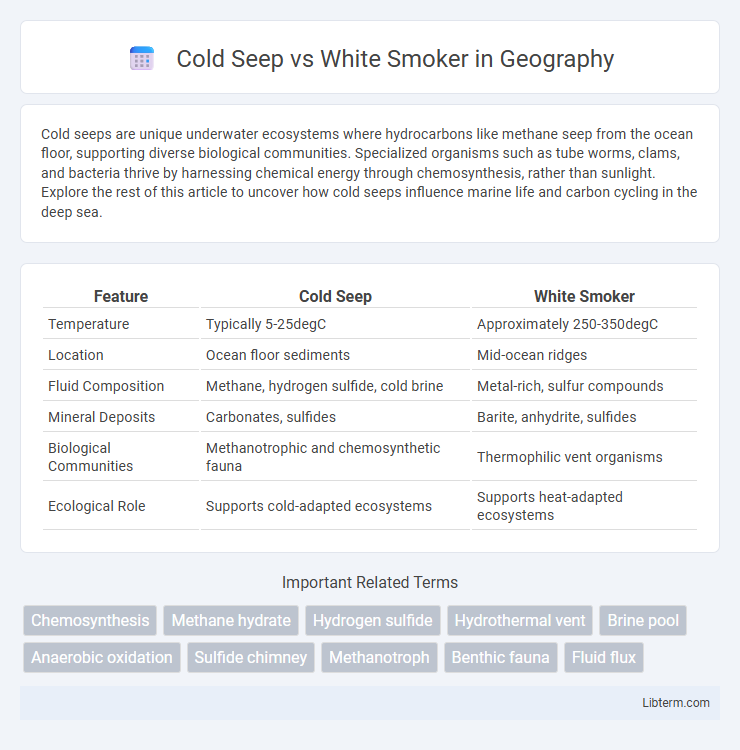Cold seeps are unique underwater ecosystems where hydrocarbons like methane seep from the ocean floor, supporting diverse biological communities. Specialized organisms such as tube worms, clams, and bacteria thrive by harnessing chemical energy through chemosynthesis, rather than sunlight. Explore the rest of this article to uncover how cold seeps influence marine life and carbon cycling in the deep sea.
Table of Comparison
| Feature | Cold Seep | White Smoker |
|---|---|---|
| Temperature | Typically 5-25degC | Approximately 250-350degC |
| Location | Ocean floor sediments | Mid-ocean ridges |
| Fluid Composition | Methane, hydrogen sulfide, cold brine | Metal-rich, sulfur compounds |
| Mineral Deposits | Carbonates, sulfides | Barite, anhydrite, sulfides |
| Biological Communities | Methanotrophic and chemosynthetic fauna | Thermophilic vent organisms |
| Ecological Role | Supports cold-adapted ecosystems | Supports heat-adapted ecosystems |
Introduction to Deep-Sea Hydrothermal Systems
Deep-sea hydrothermal systems include cold seeps and white smokers, both of which are crucial for unique biological communities formed around the ocean floor. Cold seeps emit methane-rich fluids at relatively low temperatures, supporting chemosynthetic ecosystems reliant on methane and hydrogen sulfide. White smokers, characterized by their emission of lighter-colored, mineral-rich fluids at higher temperatures, facilitate mineral deposition and host diverse microbial life adapted to extreme thermal and chemical gradients.
What Are Cold Seeps?
Cold seeps are areas on the ocean floor where methane, hydrogen sulfide, and other hydrocarbons leak from beneath the seabed, sustaining diverse ecosystems through chemosynthesis rather than sunlight. Unlike white smokers, which emit mineral-rich, heated fluids, cold seeps release cooler fluids that create unique habitats for specialized organisms such as tube worms, clams, and bacteria. These ecosystems play a crucial role in carbon cycling and support biodiversity in deep-sea environments.
Understanding White Smokers
White smokers are hydrothermal vent systems located on the deep ocean floor, characterized by the emission of clear, mineral-rich fluids that precipitate white minerals like barium, calcium, and silicon compounds. These vents form at temperatures typically ranging from 200 to 330 degrees Celsius, supporting unique ecosystems fueled by chemosynthetic bacteria that utilize the venting chemicals for energy. Unlike cold seeps, which release cooler fluids rich in methane or hydrogen sulfide, white smokers exhibit higher temperature venting and distinct mineral precipitation, shaping their specific biological and geological environments.
Geochemical Differences: Cold Seep vs White Smoker
Cold seeps emit methane-rich fluids at temperatures near ambient seawater, fostering anaerobic oxidation of methane and carbonate precipitation, resulting in distinct chemosynthetic ecosystems. White smokers discharge alkaline, metal-rich hydrothermal fluids at moderate temperatures (100-300degC), characterized by high concentrations of barium, calcium, and silicon, precipitating light-colored mineral chimneys. The geochemical contrast between methane-dominated cold seeps and mineral-laden white smokers reflects their differing fluid sources and subsurface processes.
Types of Fluids and Emissions
Cold seeps release methane-rich fluids, low-temperature hydrocarbon gases, and sulfide compounds from the ocean floor, supporting unique chemosynthetic ecosystems. White smokers emit high-temperature, alkaline fluids rich in barium, calcium, and silicon, producing distinct light-colored mineral deposits. The chemical composition and temperature of emissions differentiate cold seeps and white smokers, influencing the surrounding biological communities and mineral formations.
Microbial and Biological Communities
Cold seeps host diverse microbial communities dominated by methane-oxidizing archaea and sulfate-reducing bacteria that support chemosynthetic ecosystems, fostering rich biological communities including clams, mussels, and tube worms. White smokers emit mineral-rich fluids at moderately high temperatures, promoting the growth of thermophilic bacteria such as sulfur-oxidizing and hydrogen-oxidizing microbes that form the base of biological communities dominated by vent-specific fauna like Riftia tube worms and vent crabs. Both habitats rely on chemosynthesis but differ in temperature and chemical gradients, which shape distinct microbial assemblages and associated macrofauna.
Ecosystem Functions and Biodiversity
Cold seeps and white smokers support distinct deep-sea ecosystems by providing unique chemical energy sources that sustain specialized biodiversity. Cold seeps emit hydrocarbons like methane and hydrogen sulfide, fostering chemosynthetic communities with clams, tube worms, and diverse microbial mats, enhancing nutrient cycling and carbon sequestration. White smokers release superheated mineral-rich fluids rich in iron, manganese, and sulfides, supporting vent-specific species such as Riftia tubeworms, specialized shrimps, and extremophilic bacteria, contributing to primary production and habitat complexity in abyssal zones.
Geological Locations and Formation Processes
Cold seeps typically occur along continental margins where hydrocarbon-rich fluids escape through the seafloor at relatively low temperatures, commonly found in regions such as the Gulf of Mexico, the Cascadia margin, and the Mediterranean Sea. White smokers form at mid-ocean ridges and back-arc basins where seawater interacts with magma, leading to hydrothermal venting of mineral-rich fluids at temperatures generally between 250degC and 300degC. The geochemical environment of cold seeps supports the precipitation of carbonate and sulfide minerals, while white smokers deposit barium, calcium, and silicon minerals like barite and anhydrite during their formation.
Environmental Impacts and Resource Potential
Cold seeps emit methane-rich fluids supporting unique chemosynthetic ecosystems that contribute to carbon cycling and habitat diversity on the ocean floor. White smokers release alkaline, silica-rich fluids, fostering distinct microbial communities and precipitating valuable minerals like sulfides with potential for metal extraction. Both hydrothermal systems impact ocean chemistry and offer resource potential, but cold seeps are crucial for methane sequestration while white smokers present opportunities for deep-sea mining of rare metals.
Conclusion: Key Differences and Scientific Importance
Cold seeps and white smokers differ primarily in temperature and chemical emissions, with cold seeps releasing methane-rich, cooler fluids and white smokers emitting hotter, mineral-laden fluids rich in barium, calcium, and silicon. These distinct environments support unique chemosynthetic ecosystems that contribute to biodiversity and biogeochemical cycling in the deep ocean. Understanding their differences enhances knowledge about subsurface microbial life, mineral deposits, and global carbon cycling processes, emphasizing their scientific importance in marine geology and ecology.
Cold Seep Infographic

 libterm.com
libterm.com